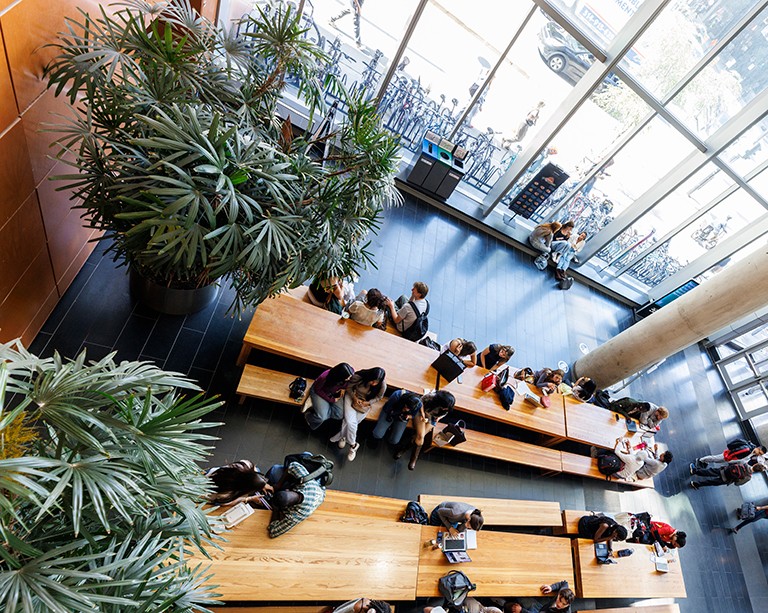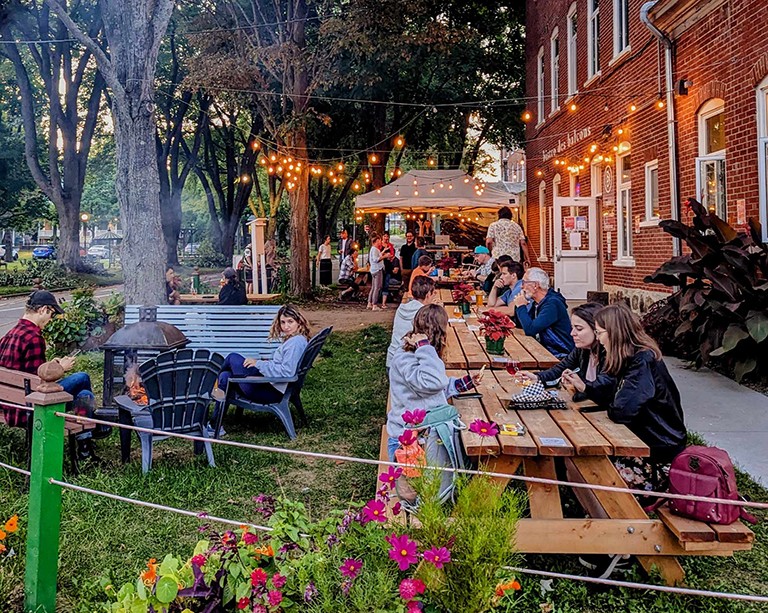Concordia’s FOFA Gallery advances sustainable art curation with the Modular Plinth project

Concordia’s FOFA Gallery is exploring new frontiers in sustainable art curation. After releasing a toolkit for more sustainable signage, its team is now rethinking the use of gallery plinths, the heavy bases or boxes that play a key role in displaying artwork in the FOFA Gallery and in exhibitions everywhere.
The Modular Plinth project is an initiative developed in collaboration with Arrien Weeks, BFA 06, MA 22. The aim is to create a more efficient, eco-friendly approach to the traditional gallery plinth.
The Modular Plinth project is part of the gallery’s broader sustainability initiative, Exploring Sustainability Across the Arts, supported by a Cultivate grant from the Canada Council for the Arts. With Weeks’s expertise, co-curators of sustainability Josh Jensen and Joé Côté-Rancourt hope to reduce resource usage and minimize waste in the gallery’s operations. They also aim to inspire other galleries by providing design and assembly files in an open-source format for wider use.
Currently, the gallery’s storage room contains plinths in various states, requiring frequent maintenance, such as repainting and repairs, to keep them exhibition-ready. This process consumes unnecessary labour, time and materials, Weeks explains. By creating modular plinths — which can be disassembled and stored flat — the gallery is reducing the space use and energy needed for storage, while cutting down on maintenance and costs. And the plinths will be made from sustainable materials: Weeks plans to explore forest-friendly sheet materials, while using 3D printing and upcycling techniques to repurpose old or damaged plinths.
"We want to ensure the process of curating exhibitions becomes more sustainable," Weeks notes. "By making the plinth system modular, we can save on resources and offer more adaptability for curators, technicians and artists."
The idea for the project was first sparked in conversation with Nicole Burisch, MA 11, director of Concordia's FOFA Gallery. Weeks then drew inspiration from his work at the Concordia University Centre for Creative Reuse (CUCCR), where he collaborated with departments to find new homes for old plinths.
Plinth project launches as part of annual undergrad exhibition
A prototype of the Modular Plinth is set to debut at the upcoming Undergraduate Student Exhibition, opening on January 13. Titled manifesting gardens, the exhibition invites audiences to reflect on themes of social movements, futurities, hope, ecosystems, regeneration and freedom(s), says María Escalona, exhibition coordinator at the FOFA Gallery and curator of manifesting gardens.
 Title wall by Hannah Ferguson and Josh Jensen, made with recuperated posters and flyers and dyed with buckthorn berry, matcha powder and watercolors, laser-cut letters. | Photo: María Escalona.
Title wall by Hannah Ferguson and Josh Jensen, made with recuperated posters and flyers and dyed with buckthorn berry, matcha powder and watercolors, laser-cut letters. | Photo: María Escalona.
Weeks is also scheduled to present a designer talk during the exhibition, alongside an event focused on sustainability in art curation. Details about the project, including the open-source connector files, will be made accessible online, further contributing to the sustainability movement in art spaces.
As for the exhibition, the showcased works will cover an array of themes and mediums.
“The focus of the works ranges from political histories to innovative approaches in archiving and denouncing collective and personal memory. The exhibition aims to inspire reflection on our personal and shared experiences and actions toward the environment, our communities and ourselves," Escalona shares.
“Some are meant to be interacted with and benefit from the human touch; others call for action and reflection. Ultimately, they all offer different perspectives and themes that I think will resonate with visitors, including takes on politics, ecology, community building, identity and underrepresented voices.”
 Left: Pascal Page's Écosystème de l'intime, 2023, ceramic, glaze. Photo: Coco Courtney | Right: Gemma Stevens' From Beneath, Towards Silence, 2023-2025, ceramic and mix media installation.
Left: Pascal Page's Écosystème de l'intime, 2023, ceramic, glaze. Photo: Coco Courtney | Right: Gemma Stevens' From Beneath, Towards Silence, 2023-2025, ceramic and mix media installation.
The artworks will be accompanied by essays that invite audiences to be vocal about past and present injustices.
Every year, the exhibition includes four components: the exhibition itself, a catalogue, essays and performances. “Each allows manifesting gardens to exist through different mediums and be experienced in different ways, and to live beyond the walls of the FOFA Gallery,” Escalona concludes.
The catalogue will launch in the spring and is being designed by students during the winter term for the Special Topics in Design (DART 498) taught by assistant professor Kevin Yuen-Kit Lo.
On February 20 at 5:30 pm, the gallery will host a finissage for the exhibition, along with dance performances by students of the Creative Process III (DANC 303 A) class taught by assistant professor Lília Mestre.
To learn more about the Modular Plinth project, the manifesting gardens exhibition and to discover the participating artists in the Undergraduate Student Exhibition, visit the Concordia FOFA Gallery's website.





